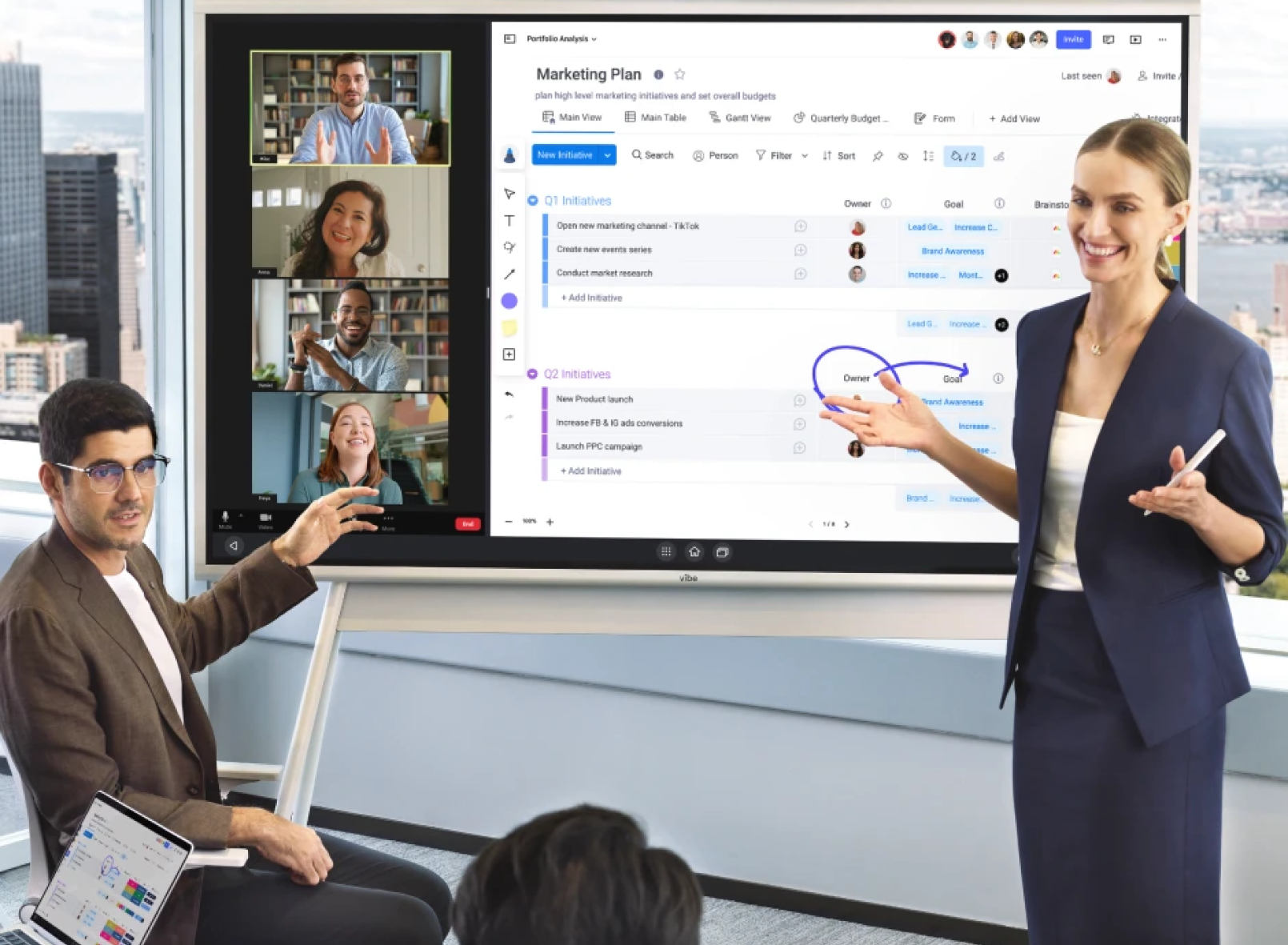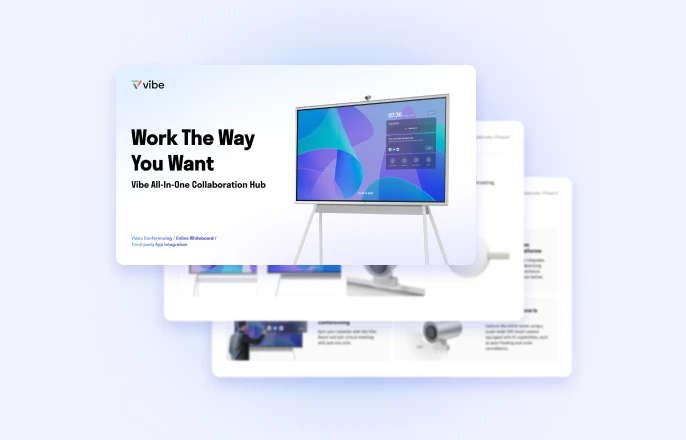"This meeting should have been an email." We’ve all felt the pain of spending an hour in a meeting that went nowhere. Plenty of workplace matters can be resolved over email and messages.
However, there are some issues and opportunities that require an "all hands on deck" approach. Here’s how you can facilitate a meeting that drives consensus, makes decisions, and leads to solutions.
- Facilitation turns routine meetings into focused, outcome-driven working sessions.
- Skilled facilitators create structure that keeps discussions inclusive, efficient, and on track.
- Practical techniques like clear agendas, timeboxing, and real-time documentation turn conversation into action.
- The right tools can streamline facilitation and more frequently lead to success.
What is Meeting Facilitation
Meeting facilitation is the practice of intentionally guiding how a meeting runs so a group can do its best thinking and reach its goals in the time available. It focuses on the structure and flow of the conversation—how topics are tackled, how decisions are made, and how time and energy are managed. Rather than centering on what gets decided, facilitation concentrates on creating a clear path that helps the group move from problem to outcome smoothly and productively.
Effective meeting facilitation also means designing the experience before anyone enters the room, from clarifying the purpose and agenda to choosing formats that encourage engagement. During the meeting, facilitation keeps people on topic and unlocks the best ideas from the group. Afterward, it ensures that decisions, next steps, and owners are captured so the work continues seamlessly once the meeting ends.

Meeting Facilitator Definition
There’s a difference between hosting and facilitating a meeting. Hosts typically set the agenda, start the meeting, and ask questions to keep the meeting moving. Facilitating a meeting entails driving consensus, efficiency, and inclusivity for the team.
Facilitators are responsible for ensuring that everyone can participate in the meeting and any decision-making that takes place. This role is neutral in nature and avoids involvement in any type of conflict during the meeting. Facilitators may be selected based on their lack of invested interest in the meeting. Doing so gives them an uniased point of view.
What Does a Meeting Facilitator Do?
What does a meeting facilitator do? Responsibilities may include any of the following:
-
Sharing the agenda, asking for talking points, and allotting time to each key section
-
Setting up any materials for the agenda, including chargers, cables, pens, paper, Zoom invitations, breakout rooms, and audio-visual equipment
-
Beginning the meeting by sharing the agenda, leading introductions, and detailing any guidelines or practices
-
Maintaining a commitment to the agenda throughout the meeting
-
Redirecting participants to the topic at hand and tabling any off-topic discussion
-
Encouraging participation
-
Summarize points made
-
Asking clarifying questions
-
Holding votes or polls to drive consensus and make decisions
-
Managing time
-
Recording notes and action items
-
Listening for potential concerns and unresolved issues

Common Co-Faciliator Roles
Depending on the size and purpose of your meeting, you may choose to have co-facilitators. These roles have the same overall purpose but take turns leading the meeting and may divide up responsibilities. Here are some other roles similar to facilitators that you may wish to include:
-
Clock-watcher: keeps an eye on the clock to ensure that the meeting ends and starts on time. They also keep track of who or what is next in line and that the time allotted to particular points in the agenda is followed.
-
Recorder: The recorder takes detailed notes, including follow-up items, and collects any materials used at the meeting.
-
Vibe-checker: This role keeps a tab on the overall atmosphere. Is everyone getting a chance to participate? Is anyone shutting down, or is a conflict brewing? They take steps to intervene when needed, so small conflicts don’t turn into larger issues.
-
Welcomer: The welcomer is a must-have at larger meetings and conferences. This role will open the doors (whether physical or virtual) to the meeting on time, direct participants to where they need to go and distribute materials.
Meeting facilitation is certainly a skill; think of it like a muscle that grows stronger the more you use it. You’ll also want to have a high degree of empathy, flexibility, and confidence.
7 Key Skills for Facilitators to Master
Key skills for facilitators help turn a basic meeting into a focused, productive working session. Strong facilitation blends structure with flexibility so the group can stay on track without feeling constrained. The skills below help facilitators support participation, navigate tension, and keep outcomes clear and actionable.
-
Active Listening
Active listening allows facilitators to truly understand what participants are saying, not just the words but the underlying concerns and motivations. Synthesizing comments into clear themes helps the group see progress and stay aligned on what has been decided.
Try: In your next meeting, paraphrase what someone has said before responding, and ask them to confirm you captured it accurately.
-
Clear Communication
Facilitators need to explain goals, processes, and agenda items in simple, direct language so everyone knows what is happening and why. They also communicate time checks, transitions, and next steps in a way that keeps momentum without overwhelming people.
Try: Before the meeting, write a one-sentence purpose and one-sentence desired outcome, and read both aloud at the start.
-
Neutrality and Objectivity
Maintaining a neutral stance helps the facilitator focus on process rather than pushing a particular outcome. This objectivity builds trust so participants feel safe sharing candid opinions and challenging assumptions.
Try: When a contentious topic comes up, consciously describe options and trade-offs without adding your own preference or judgment.
-
Team Dynamics and Inclusion
Reading the room and managing group energy are essential to keeping people engaged. Facilitators draw out quieter voices, manage dominant speakers, and use formats that give everyone a fair chance to contribute.
Try: Hold a quick round where every participant has 30–60 seconds to share, and don’t move on until every voice has been heard.
-
Conflict Navigation
When disagreements surface, facilitators help surface the real issues and guide the group toward shared interests. They keep discussions respectful and focused on problem-solving instead of letting conversations become personal or unproductive.
Try: When tension rises, pause the discussion and ask each side to name the core issue in one sentence, then look for a shared goal.
-
Time Management
Strong facilitators protect the group’s time by pacing discussions, parking tangents, and adjusting when certain topics need more or less attention. They use the agenda as a guide, not a script, to ensure critical items are covered and decisions are made.
Try: Assign rough timeboxes to each agenda item and set a visible timer so you can give a one-minute warning before moving on.
-
Documentation and Follow-Up
Capturing decisions, owners, and deadlines in real time ensures that the meeting’s work translates into action. Facilitators also confirm shared understanding before closing so there is no ambiguity about what happens next.
Try: Designate a "recorder" and end the meeting by reviewing the captured decisions, owners, and deadlines together.
Mastering these skills enables facilitators to create meetings where people feel both heard and productive. Over time, these capabilities help teams build better habits around collaboration, decision-making, and accountability.
Benefits of Effective Meeting Facilitation
Effective meeting facilitation leads to tangible, organization-wide benefits that extend far past the meeting itself. When meetings are planned and guided with intention, teams unlock higher levels of creativity, efficiency, and accountability. These improvements strengthen collaboration and help groups use collective time and expertise more wisely.
Stronger Alignment on Goals
Facilitated meetings clarify objectives and ensure everyone is heard, which leads to shared understanding about what the team is working toward. Aligned teams are more likely to execute effectively and avoid confusion or duplicated effort. This clarity keeps projects and priorities moving forward with fewer miscommunications and setbacks.
Higher Engagement and Participation
A skilled facilitator creates space for all voices to contribute, resulting in more diverse perspectives and increased buy-in from participants. When people feel their input matters, they are more invested in the outcome and open to collaboration. This engagement translates into more creative solutions and increased morale for the team.
Faster, More Confident Decision-Making
Effective facilitation keeps discussions focused, surfaces key issues, and uses efficient decision protocols, helping teams move from deliberation to action without unnecessary delays. Clear decision-making structures prevent "meeting fatigue" and support confident follow-through. As a result, teams can respond quickly to new information and changing circumstances.
Consistent Follow-Through and Accountability
Facilitators document decisions, assign owners, and clarify next steps, turning conversation into action. This structure reduces the risk of forgotten tasks or unresolved issues and reinforces a culture of accountability across the team. Regular, well-facilitated meetings help sustain momentum for ongoing projects and continuous improvement.

Tips and Techniques to Improve Your Meeting Facilitation
Decide If a Meeting is Truly Needed
Not every problem deserves calendar space, and one of the most powerful facilitation moves is deciding when not to meet. Treat meetings as a high-value resource for issues that genuinely need real-time collaboration, such as complex decisions, cross-functional alignment, or sensitive topics. When you’re selective, people quickly learn that a meeting invite signals something worth their attention.
To put this into practice, add a quick "meeting filter" to your workflow: before scheduling, ask, "Could this be handled via email, comments in a shared doc, or a brief recording?" If the answer is yes, choose the async route and note the decision. If a meeting is warranted, write a concise meeting brief and a one-sentence desired outcome in the invite to make that choice transparent.
Take The Participant’s Point of View
Strong facilitators think about meetings as experiences, not just time slots with an agenda. That means considering energy levels, context, and what each person needs to contribute for the time to feel well spent. When participants feel the flow makes sense for them, they engage more fully and are less likely to tune out or multitask.
Draft your agenda with three passes: first list what needs to be decided, then what information or context participants need to get there, and finally what format best supports each step (brief update, round-robin, small-group discussion, etc.). Order items so the group warms up on simpler topics before tackling anything high-stakes, and avoid stacking multiple "heavy" items back-to-back.
Utilize The Right Tools
The tools you choose can either amplify great facilitation or make even the best agenda feel clunky. Effective meetings rely on platforms and devices that make it easy to see information, collaborate together, and capture decisions where the work actually lives. Matching the tools to your group’s needs helps participants stay focused on the discussion instead of wrestling with technology.
Start by identifying what your attendees need to be successful. Shared documents, digital whiteboards, project management boards, or video and audio that work seamlessly for hybrid participants? Share resources ahead of time and during the meeting, actively and consistently use these tools to establish effective habits.
Facilitate Meetings Easily with Vibe Board S1
Interactive whiteboards give you a visual, shared space where everyone can see the same information, contribute ideas in real time, and stay anchored to the agenda and outcomes. Instead of flipping between screens, notes, and apps, you can bring everything into a single, living canvas that evolves with the conversation.
Vibe Board S1 gives facilitators one hub for everything that happens before, during, and after a meeting. Rather than juggling laptops, cables, and scattered notes, you can present, whiteboard, and capture decisions in one place that saves seamlessly to the cloud. With support for your favorite video conferencing, productivity, and hundreds of other apps, it keeps in-room and remote participants working side by side on the same content in real time. When you’re ready to put better facilitation into practice, Vibe helps you do it without adding extra complexity.
If you’re ready to improve your meetings through effective facilitation, request a demo to see how the process can be simplified with tools like Vibe.
Meeting Facilitation FAQs
What are the 3 P’s of facilitation?
The 3 P’s of facilitation are usually described as Purpose, People, and Process, meaning you clarify why you’re meeting, who needs to be there, and how you’ll use the time to reach outcomes. Together, they give facilitators a simple checklist to design meetings that are focused, inclusive, and productive.
What types of meeting facilitation exist?
Common types include decision-making sessions, brainstorming and innovation workshops, planning or roadmap meetings, retrospectives, and training or onboarding sessions. Each type uses different structures and techniques, but all rely on a facilitator to guide the group toward clear outcomes.
How is facilitating different then chairing a meeting?
A chair typically focuses on governance—following formal procedure, managing speaking order, and ensuring the required business is covered. A facilitator focuses on the group’s process and dynamics, staying neutral while helping participants collaborate, explore options, and reach shared decisions.









-1sbltxxq4FYxHrXrwJVLsCDNsXpqNa.webp)
-5Zp0pmSytvcuYDVs1LvuwplKuRneK0.webp)
